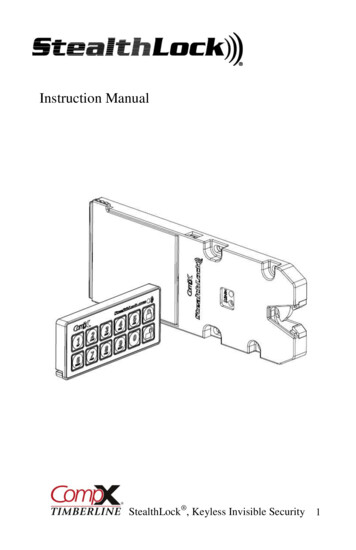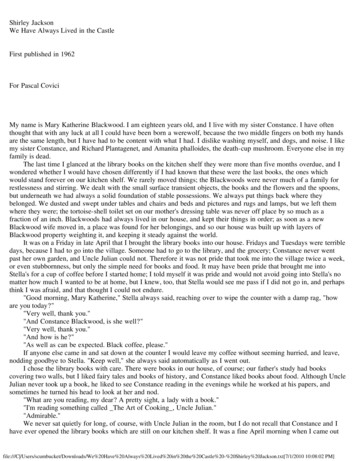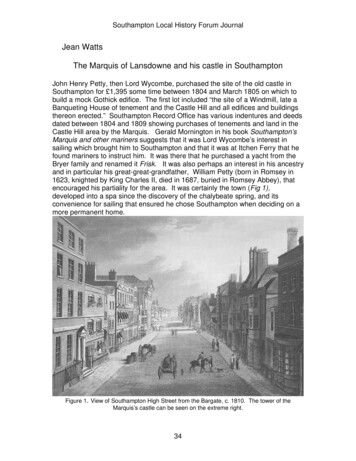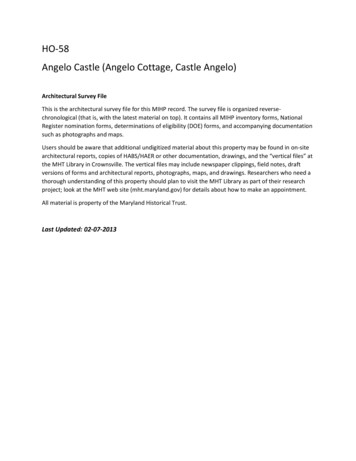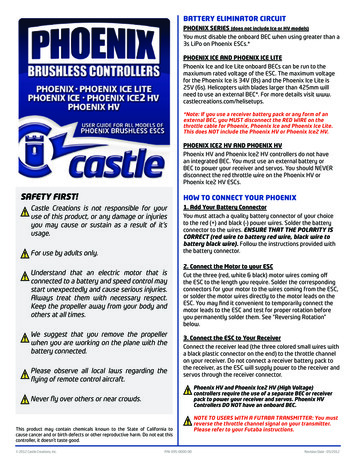
Transcription
BATTERY ELIMINATOR CIRCUITPHOENIX SERIES (does not include Ice or HV models)You must disable the onboard BEC when using greater than a3s LiPo on Phoenix ESCs.*PHOENIX ICE AND PHOENIX ICE LITEPhoenix Ice and Ice Lite onboard BECs can be run to themaxiumum rated voltage of the ESC. The maximum voltagefor the Phoenix Ice is 34V (8s) and the Phoenix Ice Lite is25V (6s). Helicopters with blades larger than 425mm willneed to use an external BEC*. For more details visit www.castlecreations.com/helisetups.*Note: If you use a receiver battery pack or any form of anexternal BEC, you MUST disconnect the RED WIRE on thethrottle cable for Phoenix, Phoenix Ice and Phoenix Ice Lite.This does NOT include the Phoenix HV or Phoenix Ice2 HV. PHOENIX ICE2 HV AND PHOENIX HVPhoenix HV and Phoenix Ice2 HV controllers do not havean integrated BEC. You must use an external battery orBEC to power your receiver and servos. You should NEVERdisconnect the red throttle wire on the Phoenix HV orPhoenix Ice2 HV ESCs.SAFETY FIRST!HOW TO CONNECT YOUR PHOENIXCastle Creations is not responsible for youruse of this product, or any damage or injuriesyou may cause or sustain as a result of it’susage.For use by adults only.Understand that an electric motor that isconnected to a battery and speed control maystart unexpectedly and cause serious injuries.Always treat them with necessary respect.Keep the propeller away from your body andothers at all times.We suggest that you remove the propellerwhen you are working on the plane with thebattery connected.Please observe all local laws regarding theflying of remote control aircraft.1. Add Your Battery ConnectorYou must attach a quality battery connector of your choiceto the red ( ) and black (-) power wires. Solder the batteryconnector to the wires. ENSURE THAT THE POLARITY ISCORRECT (red wire to battery red wire, black wire tobattery black wire). Follow the instructions provided withthe battery connector.2. Connect the Motor to your ESCCut the three (red, white & black) motor wires coming offthe ESC to the length you require. Solder the correspondingconnectors for your motor to the wires coming from the ESC,or solder the motor wires directly to the motor leads on theESC. You may find it convenient to temporarily connect themotor leads to the ESC and test for proper rotation beforeyou permanently solder them. See “Reversing Rotation”below.3. Connect the ESC to Your ReceiverConnect the receiver lead (the three colored small wires witha black plastic connector on the end) to the throttle channelon your receiver. Do not connect a receiver battery pack tothe receiver, as the ESC will supply power to the receiver andservos through the receiver connector.Phoenix HV and Phoenix Ice2 HV (High Voltage)controllers require the use of a separate BEC or receiverpack to power your receiver and servos. Phoenix HVControllers DO NOT have an onboard BEC.Never fly over others or near crowds.This product may contain chemicals known to the State of California tocause cancer and or birth defects or other reproductive harm. Do not eat thiscontroller, it doesn’t taste good. 2012 Castle Creations, Inc.P/N: 095-0000-00NOTE TO USERS WITH A FUTABA TRANSMITTER: You mustreverse the throttle channel signal on your transmitter.Please refer to your Futaba instructions.Revision Date - 05/2012
4. Reversing Rotation (if necessary)Bench test the motor and speed control after theconnections are made to determine the rotation of the motor.To change the rotation of the motor, swap ANY two motorwire connections, or use the Castle Link USB interface tochange the rotation direction.5. Mounting the ESCWe recommend using Velcro to attach the ESC to theairframe for easy removal. Double sided tape is alsoacceptable. If zip ties are used, do not place them over any ofthe components on the ESC. Instead, zip tie around the motorand battery wires, leaving some slack to allow for movement.USING YOUR PHOENIXYou must follow this initialization sequence before themotor will operate.Safe Power To arm the controller, the throttle must be held inUpthe “Brake” position (all the way down). Until thecontroller is armed, it will not provide anypower to the motor regardless of where thethrottle stick on your transmitter is positionedwhen first powered up.Programmable Options can be changed at the discretion ofthe user. The Phoenix comes with default or factory settingson these options which are the best for most applications.You may change these settings using your transmitter andreceiver or with the Castle Link, which is sold separately.There are more programmable options available with theCastle Link, these extra settings are not easily made usingthe YES/NO abilities of the stick programming mode.LowVoltageCutoffESC optionally stops or ramps down the motorpower when the input battery voltage drops to theprogrammed cutoff voltage.CurrentLimitingESC optionally detects an over-current and shutsdown to protect it’s circuitry.2. Turn your transmitter ON and set the throttle stick to midthrottle.BrakeStops rotation of the motor when the throttlesignal is moved to the lowest position.3. Connect the main power battery to the speed controller.The speed controller will remain disarmed and will notoperate the motor until it sees zero throttle.ThrottleAllows user to choose between the Phoenixautomatically calibrating the throttle endpointsevery time it is powered up, using preset throttleendpoint settings, or using one of a number ofhelicopter specific settings.ElectronicTimingAdvanceA setting that may improve the efficiency of thesystem for some motors. The standard Phoenixsetting is to automatically detect and adjust for themotor it is driving.LowVoltageCutoff TypeSelect the method of cutoff employed by thePhoenix when the low voltage set in #1 is reached.Options are Hard Cutoff and Soft Cutoff.1. Ensure that the Phoenix is connected to the properchannel on your receiver.4. When you are ready to fly, move the throttle stick to thelowest position on your transmitter.The Phoenix will beep the motor to indicate that it is armed.The Phoenix will not provide any power to the motor,regardless of where the throttle stick on your transmitteris positioned when first powered up. You must move thethrottle stick to its lowest position to arm and use thePhoenix.Always power your radio transmitter before powering upthe receiver and/or the ESC. Some receivers with failsafefeatures or Spektrum receiver units that are not bound onreceiver power up are entirely capable of causing thearming sequence to occur and command the ESC to drivethe motor. Always keep the aircraft restrained and clear ofbody parts when the ESC is powered.Always perform a range check at full, half, and zerothrottle before flying with any new speed controller! Forhelicopters, range check with the blades off the helicopterat full, half, and zero throttle.Notes on the Features of Your PhoenixStandard Features are always employed by the Phoenix.Problem: The BEC (receiver and servos) works, but themotor does not respond to throttle.Solution: The controller may not be seeing a low enoughthrottle signal to arm. Increase the low side throttleendpoint in your transmitter until you hear the ESC arm. Ifyou do not have a computer transmitter, bring the throttlestick and throttle trim all the way down to arm the ESC. Ifusing a Futaba transmitter, verify the throttle channel isreversed.(continued on next page)LEDThe LED is used for programming the features onthe Phoenix. Once armed, the LED also providesan indication that the controller has reached fullthrottle by lighting continuously.Loss ofSignalThe Phoenix will stop the motor as a safety featurewhen the throttle signal is lost or corrupt. Movingthe throttle to the brake position for two secondsmay be required to rearm the motor. 2012 Castle Creations, Inc.TROUBLESHOOTINGP/N: 095-0000-00Revision Date - 05/2012
Problem: When I throttle all the way up, the controller“cuts off”, even with fully charged batteries.6 beepsOver temperatureand flashesSolution: The controller will automatically shut or rampdown the motor (depending on which cutoff type isselected) if the battery voltage falls below the cutoffvoltage. Your controller will repeatedly blink the LEDwith 2 flashes. If the cutoff occurs with freshly chargedbatteries, it means that the voltage has dropped veryquickly. This is usually an indication of a power systemthat is drawing too much current for the batteries tohandle. Try using a smaller prop on the motor or use a packwith a higher mAh capacity.Problem: The LED comes on when I go to full throttle.Solution: This is normal. The LED comes on when fullthrottle has been reached. If the unit is in Auto-CalibratingThrottle mode (program setting 4-1) then you may seefull throttle LED indication before the stick is in the full upposition. Simply continue moving the stick to full up. Thecontroller will detect the high stick travel and adjust fullthrottle accordingly.Problem: Nothing is working – receiver, servos, and motorare all dead.Solution: Check all connections to ensure that the polarity( /-) of the connections are correct (especially the receiverplug polarity). If everything is correctly connected, contactthe dealer where you purchased your Phoenix ESC orcontact Castle Creations directly.Error Codes:The following error codes are only applicable to controllersrunning version 1.55 or made after December 15, 2006. Thecontroller will alert you to errors by blinking the LED andbeeping the motor. Please count the error code beeps orflashes and use the following chart to determine the issue.1 beep andflash2 beepsLow Voltage Cutoff: Your batteries are likelyand flashes discharged. Check that batteries are fully chargedand that Phoenix detects the proper number ofcells at power-up.3 beepsOver-Current: Current draw exceeded the safeand flashes capacity of the controller. Reduce current drawby changing to a smaller propeller, different gearcombination, or fewer cells.4 beepsMotor Anomaly: Controller encountered abnormaland flashes motor behavior such as a prop strike or otherphysical interference. May also indicate lostsynchronization or magnetic overload within themotor.(continued in next column) 2012 Castle Creations, Inc.Red LED Blinks out cell-counts /error codes Flashes a little at low throttle Flashes a lot at high throttle Solid on at full-throttle Pulses quickly when governor-mode is lockedYellow LED - used for Data Logging (Phoenix Ice, Phoenix Ice Liteand Phoenix Ice2 HV only) Yellow LED flashes when logging, and is on continuouslywhen log is full.Green LED - not currently used - reservedLook for more troubleshooting tips on the CastleCreations website at:www.castlecreations.com/supportCONTACT & WARRANTY INFOYour Phoenix ESC is warranted for one year from date ofpurchase to be free from manufacturing and componentdefects. This warranty does not cover abuse, neglect, ordamage due to incorrect wiring, over voltage, or overloading.If you have any questions, comments, or wish to returnyour Phoenix ESC for warranty or non-warranty repair orreplacement, contact Castle Creations, Inc. at:Phone: (913) 390-6939Fax: (913) 390-6164540 North Rogers RoadOlathe, Kansas 66062 USAwww.castlecreations.comNON-WARRANTY REPAIRSStart failure: The motor was jammed or locked.5 beepsRadio Signal: Signal from receiver is corrupt orand flashes non-existent. Check transmitter and receiver.Beep Codes/ConditionsAll Castle ESCs will sound a single beep every 20 seconds toremind the user that the controller is connected to a batteryand drawing power. Leaving a controller connected to abattery for extended periods will likely damage the battery.Never throw away a damaged Phoenix! You may send itto Castle and take advantage of our flat price replacementoffer. Please check our website for specific pricing.PROGRAMMING PHOENIX AND PHOENIX HVESCSPhoenix Series controllers offer users the option of changingprogrammable settings. You do not need to programanything to make the controller work. Programming is onlynecessary if you wish to change the default settings or ifyou wish to use advanced features such as helicopter modes.If you need to change settings, we highly recommend usingthe Castle Link (sold separately). It is easier and allows youto modify many more settings than the “stick” programmingprocedure described below. Please note that there areP/N: 095-0000-00Revision Date - 05/2012
many features that may only be accessed via CastleLink.Connecting Phoenix and Phoenix Ice Series to CastleLinkThe Phoenix line is capable of drawing power for CastleLink operation from the USB port and does not require anexternal power source.not need to continue through the programming steps forthe remaining settings. Once you have programmed each ofthe features you wish to change and the Phoenix ESC hasconfirmed the selection, instead of returning to mid-throttlefor the next question, disconnect battery power, re-connectpower, and arm the speed control as normal.Connecting Phoenix HV and Phoenix Ice2 HV to CastleLinkYou must power the Phoenix HV using a battery pack on thebattery leads in order to power the onboard processor forCastle Link operation. This is necessary because the throttlelead/Castle Link serial wire is optically isolated from thecontroller and cannot provide power from the USB port tothe controller. Any pack of 4s or larger will be sufficient forthis purpose. You must plug the HV controller into the CastleLink before you plug in your battery pack. The ESC will notlink if connected out of order.Manually Changing Programmable SettingsThe Phoenix ESC software is designed to make it difficult toaccidentally enter programming mode. Once in programmingmode, the Phoenix ESC “asks” questions by beeping andflashing the setting number, followed by the number for eachof the setting values. You must answer “yes” or “no” bymoving the throttle stick on your transmitter to each of thesetting values as the Phoenix ESC presents them. The valuesare always presented in sequence, and do NOT “tell you”what any of the settings are currently programmed for.The current setting and setting value are “flashed” out bythe LED. (For example if you are on setting #3 and value #2,there will be 3 beeps/flashes, then 2 beeps/flashes repeatinguntil you answer). Answering “no” to a setting value willcause the Phoenix ESC to ask for the next value in sequence.Answering “yes” to a setting value will store that setting inthe permanent memory, and skip to the next setting.NOTE: If you answer “no” to all values for a particularsetting, the ESC will keep whatever value had beenpreviously programmed. Only by answering “yes” to avalue will the Phoenix ESC store/change any value.You will need to move the transmitter stick to the “yes”(full throttle) position or the “no” (zero throttle) position toanswer the question. When the Phoenix ESC has acceptedyour answer, it will flash the LED rapidly, and emit a constantbeeping. Move the throttle stick back to the middle positionfor the next question.Clearing the Phoenix Ice and Ice2 HV data logPower your controller up with your TX & RX on and set tofull throttle. The controller will chime the normal power upchimes. Leave your TX at full throttle for 6 seconds afterpower up. The controller will emit a short tone after 1second and then a long tone 5 seconds later. The controllerwill then erase the data log. You must then move the throttlestick to lowest power to arm the controller.1. Enter Programming Mode1A. The Phoenix controller must be connected to a motorin order for you to hear the programming beeps. Turn yourtransmitter on, and leave the Phoenix ESC unpowered.Move the transmitter stick to the top position (full throttle).1B. Connect battery power to the Phoenix ESC. The PhoenixESC will beep its initialization tones when first pluggedin. After a short period of time the Phoenix ESC will emitanother short tone and the LED on the Phoenix ESC shouldflash a short, single flash that repeats. If the ESC flashescontinuously it is not seeing a full throttle position. Moveyour throttle trim to the top position or increase your fullthrottle endpoint or ATV on your transmitter.1C. Move your transmitter stick to the middle position. ThePhoenix ESC will emit another short tone, and the LED on thePhoenix ESC should flash a short, double flash that repeats.1D. Move your transmitter stick back to the top positionagain. After a short time, the Phoenix ESC will emit a shorttone, and the LED on the Phoenix ESC should flash a short,triple flash that repeats.1E. Move your transmitter stick back to the middle positionagain. The Phoenix ESC will emit four short tones in a row,and the LED on the Phoenix ESC will start a repetitive flashsequence of a single flash followed by a long pause.The Phoenix ESC is now in programming mode and askingyou the first question.2. Enter your SettingsNOTE: When setting LiPo cutoff voltage, always followyour battery brand recommendations.After you have verified that the controller works properly,follow the steps below to change settings.If you wish to re-program only some of the features you do 2012 Castle Creations, Inc.P/N: 095-0000-00Revision Date - 05/2012
Setting 1A: Cutoff Voltage - Phoenix/Phoenix IceOptionRecommended Use1AutoLiPo*Automatically detects LiPo cell count, and sets 3.2v/cell cutoff voltage. Safe for use with any LiPo packs,but DO NOT use with NiMH/NiCad packs. The PhoenixESC will beep the number of cells it’s detectedimmediately after the initialization tones, and beforethe arming tones. This is the FACTORY setting.24.0VCutoff5 cell NiCad or NiMH packs only.35.0VCutoff5-8 cell NiCad or NiMH packs only.46.0VCutoff5-10 cell NiCad or NiMH packs, or safe for 2 cell onlyLiPo packs.59.0VCutoff5-16 cell NiCad, 5-16 cell NiMH, or safe for 3 cell onlyLiPo packs (BEC MUST be disabled for MORE than10 NiMH/NiCad cells).612.0VCutoffUp to 16* cell NiMH or NiCad packs, or safe for 4 cellLiPo packs (BEC MUST be disabled for MORE than10 NiMH/NiCad cells, or 3s LiPo).*up to 20 cells with PHX 60/80/1254Insensitive**Recommended setting for all helicopters andLMR applications (covered under warranty).5DisabledUse at your own risk!Setting 3: Brake TypeSoft brake provides 50% of full braking power; hard brake is100% braking power.OptionRecommended Use1 Soft DelayedBrake*General aircraft use, with fixed or foldingprop. This is the FACTORY setting forPhoenix and Phoenix HV controllers.2 Hard DelayedBrakeDirect drive applications where morebraking power is required.3 Soft Brake – NoDelayCompetition use where a very short brakedelay is required.4 Hard Brake – NoDelayCompetition use where a very short brakedelay is required. Brake action may be veryabrupt. Be very cautious with highpowered setups.5 Brake Disabled*Helicopters, 3D airplanes, and by choice,on most aerobatic airplanes. This is theFACTORY setting for Phoenix Icecontrollers only.Setting 1B: Cutoff Voltage - Phoenix HV/Phoenix Ice2 HVOptionRecommended Use1Automatically detects LiPo cell count, and sets3.2v/cell cutoff voltage. Safe for use with anyLiPo packs, but DO NOT use with NiMH/NiCadpacks. The Phoenix ESC will beep the numberof cells it’s detected immediately after theinitialization tones, and before the arming tones.This is the FACTORY setting.Auto-LiPo*212V Cutoff4s LiPo packs318V Cutoff6s LiPo packs424V Cutoff8s LiPo packs530V Cutoff10s LiPo packs636V Cutoff12s LiPo packsNOTE: 3.2v per cell is the lowest cutoff that should be usedfor LiPo packs. Some cell manufacturers may recommendhigher voltages. Please use the cutoff recommended foryour cells.Setting 2: Current LimitingNOTE: Change this setting at your own risk! Damage to thecontroller as a result of over-current is NOT covered by themanufacturer’s warranty.** Only experienced modelersshould use this programming feature. Current limitingdescribes the reaction of the Phoenix ESC when anover-current condition is detected.OptionRecommended Use1VerySensitiveWill rapidly shut down when over current isdetected.2Sensitive3Normal*Setting 4 – Throttle TypeOptionRecommended Use1 AutoCalibratingThrottle*Any fixed wing aircraft, but NOT for use withhelicopters. When using Auto Calibrating Throttle,you must throttle up to full throttle for fourseconds and back to the off position each timeyou power up and fly your airplane. This willset the automatic throttle endpoints within thecontroller. This is the FACTORY setting.2 FixedThrottleAny fixed wing aircraft, fixed pitch helicopters,and collective pitch helicopters using a manuallycreated and tuned pitch and throttle curveon your transmitter. This mode uses normallyaccepted TX throttle endpoints; some TX throttlesignals are outside these values. Use autocalibrating throttle for those setups.THE FOLLOWING ARE FOR HELICOPTER APPLICATIONSONLYWe highly recommend programming your ESC using the CastleLink USB Programming Kit to gain access to advanced helicoptersettings that are not accessible with throttle programming.(continued on next page)Moderate over-current threshold, will shutdown after a slight delay. Recommended forall systems except for helicopters and highpower LMR applications. This is the FACTORYsetting.(continued in next column) 2012 Castle Creations, Inc.P/N: 095-0000-00Revision Date - 05/2012
3 GovernorMode LOWFor collective pitch helicopters only: Governormode acts as an RPM control, rather than athrottle control. Throttle stick position (orthrottle curve %) determines the RPM that themotor will run and the controller will attemptto hold that RPM regardless of how the load(collective) changes. This is useful in a collectivepitch helicopter where a constant head speedis desirable. The low RPM range has finer RPMcontrol at lower RPMs. The low RPM range isuseful for low pole count motors (Hacker, Feigao,HiMax, etc.) and low RPMs on higher pole countmotors. Brake is ALWAYS disabled in GovernorMode.4 GovernorSame operation as Low Governor, but allows forMode HIGH higher head speeds if the desired head speedcannot be reached in Low Governor. RPM rangehas finer RPM control at higher RPMs. The highRPM range is useful for higher pole count motors(Aveox, Astro, Mega, Neu, and all outrunners)and higher RPMs. Brake is ALWAYS disabled inGovernor Mode.Setting 5: Electronic Timing AdvanceElectronic timing advance may be used to fine tune eithera bit more power or a bit more efficiency out of an electricpower system.Setting 7: Soft StartOptionRecommended Use1 VerySoftStartGovernor mode: slowest spool up, and softest start.Other throttle types: softest start, most throttlechange dampening.2 SoftGovernor mode: soft start, medium spool up. OtherStart* Throttle types: soft start, slight throttle changedampening. This is the FACTORY setting.3 FastStartGovernor mode: faster start, fast spool up. Best onmanually optimized pitch and throttle curves withfixed throttle type. Other throttle types: fast start,least throttle change dampening.Setting 8: PWM Switching RateNote: The following settings apply only to the Phoenix-35and above.OptionRecommended Use112 kHzRecommended for most brushless motors.216 kHzRecommended for low inductance motors. RARE.Suggested for Kontronik Tango motors.324 kHzRecommended for very low inductance motors.4Outrunner Recommended for all outrunner motors.ModeOptionRecommended Use1 HighAdvanceMay give an increase in RPM and current draw atthe expense of runtime and a hotter motor andbatteries.If you choose, you may simply connect the wires to yourcomponents and go fly.2 StandardAdvance*Almost always the best balance of power andefficiency for any motor. This is the FACTORYsetting.The following standard settings will work for mostapplications.3 LowAdvanceMay slightly decrease RPM and current draw,and will give longer runtime and a cooler motorand batteries. This is the preferred setting foroutrunner motors.PHOENIX ESC REQUIRES NO PROGRAMMING!STANDARD SETTINGS: Auto-LiPo cell detection with soft cutoff when cellsreach discharged state Throttle Range is self-adjustingSetting 6: Low Voltage Cutoff TypeOptionRecommended Use1HardCutoff*Will shut the motor off when theprogrammed cutoff voltage isreached. The motor may be restarted by loweringthe throttle to the brake position, and re-arming.For gliders and some parkflyers where a “motor off”situation does not put the modelin danger. This is the FACTORYsetting.2SoftCutoffInstead of turning the motor off, the Phoenix ESCramps down the throttle to safely maintain thebattery voltage at the programmed cutoff level. Veryuseful for 3D flying, indoor flying, all helicopters,and most any sport flying where you do not wantthe motor to turn off when the low voltage cutoff isreached. Auto motor cutoff when radio signal is lost or radiointerference becomes severeThe Castle Link USB programming kit (sold separately)gives you access to many advanced programming options,such as incredible helicoptergovernor modes, control linegovernor settings, motor timing,audible alert tones, as well asincredible data logging capabilitiesfor the Phoenix Ice. Please visitcastlecreations.com to download thelatest software!Designed in KansasComponents manufactured in the USA, Mexico, and China.Castle Creations logos and Phoenix logos are trademarks of Castle Creations, Inc.This manual is copyright Castle Creations, Inc. 2012.U.S. patent #7,492,122 and 7,400,103 apply. Other patents pending. 2012 Castle Creations, Inc.P/N: 095-0000-00Revision Date - 05/2012
PHOENIX SERIES (does not include Ice or HV models) You must disable the onboard BEC when using greater than a 3s LiPo on Phoenix ESCs.* PHOENIX ICE AND PHOENIX ICE LITE Phoenix Ice and Ice Lite onboard BECs can be run to the maxiumum rated voltage of the ESC. The maximum voltage for the Phoenix Ice is 34V (8s) and the Phoenix Ice Lite is 25V (6s).


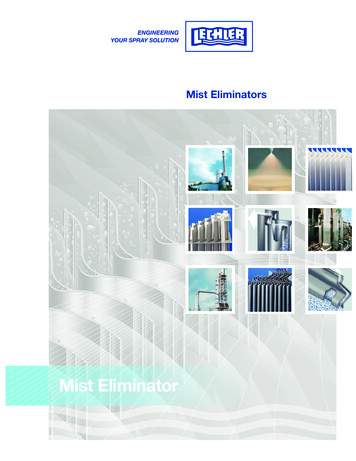
![Smarter Battery Crack [2022-Latest]](/img/13/eliamari.jpg)

